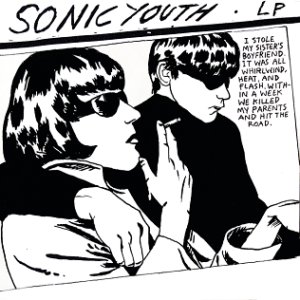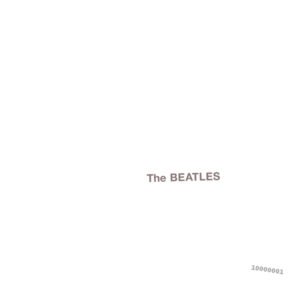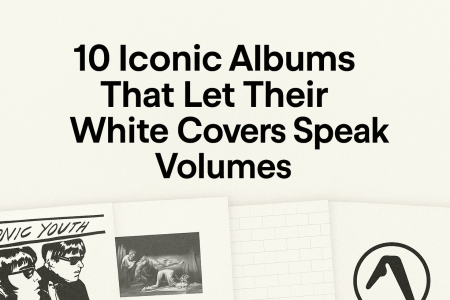In a world where album art often competes to be the loudest in the room, white covers take the opposite approach — quiet, stark, and bold in their simplicity. A white sleeve can suggest purity, grief, irony, or reinvention. It can wipe the slate clean or magnify the chaos within. These ten albums, ranked from ten to one, use white not just as a design choice, but as a reflection of the music and message they carry.
10. Goo – Sonic Youth (1990)

With its white backdrop and bold black illustration by Raymond Pettibon, Goo sets the tone before a note plays. The drawing, inspired by pulp culture, portrays two characters mid-conversation — a nod to the band’s ironic, art-damaged sensibility. Beneath the chaotic guitars and experimental song structures, there’s clarity and structure, much like the contrast between the sketchy image and the clean white space that surrounds it.
9. Closer – Joy Division (1980)

The stark white framing of Closer‘s funereal imagery perfectly echoes the emotional landscape of the music. With its minimal black-and-white photo of a tomb sculpture, the album communicates its themes of loss, distance, and mortality before a sound is heard. Released shortly after Ian Curtis’s death, the cover became inseparable from the band’s tragic legacy — and the cold, spacious production only deepens that sense of elegy.
8. The Wall – Pink Floyd (1979)

A white brick wall is all you see on this iconic double album — no title, no band name, just the cold, anonymous structure. That wall becomes a central metaphor throughout the record, representing emotional distance, trauma, and authoritarian control. From the isolation of “Hey You” to the explosive drama of “Another Brick in the Wall,” the cover’s blankness becomes a canvas for the psychological chaos within.
7. Fleetwood Mac – Fleetwood Mac (1975)

Fleetwood Mac’s self-titled album marked the beginning of their most famous lineup, with the arrival of Lindsey Buckingham and Stevie Nicks. The white cover, featuring a quirky photo of Mick Fleetwood and John McVie, sets a playful yet stripped-down tone that matched the band’s shift toward melodic, emotionally rich pop. Songs like “Rhiannon” and “Landslide” redefined the band’s sound, and the pale, minimalist sleeve mirrored that reinvention.
6. Blink-182 (Untitled) – Blink-182 (2003)

This album saw Blink-182 step away from their adolescent antics toward something more introspective. The white cover, with just a small pink-and-blue icon in the center, marked a major tonal shift. The clean slate design mirrored the record’s emotional depth and experimentation, heard in tracks like “I Miss You” and “Stockholm Syndrome.” The minimalism was a surprise — and a statement — from a band known for bold, bratty visuals.
5. White Blood Cells – The White Stripes (2001)

Red, black, and white were The White Stripes’ visual signature, but White Blood Cells put its white background front and center. Against that pale canvas, Jack and Meg White are flanked by shadowy figures, creating a sense of tension and movement. The stripped-down imagery matches the rawness of the record itself — a lo-fi blast of blues and garage rock, where every note cuts sharp and clean.
4. Selected Ambient Works 85–92 – Aphex Twin (1992)

Aphex Twin’s ambient debut arrives in a white sleeve almost devoid of decoration — just a faint logo and minimal text. That visual austerity reflects the music’s quiet power. These tracks drift between ambient, acid, and early IDM, and the cover’s sterile appearance gives no hint at the emotional depth inside. It’s an album that reveals itself slowly, and the blankness of the design invites deeper listening.
3. Led Zeppelin – Led Zeppelin (1969)

The band’s explosive debut album features a black-and-white photo of the Hindenburg disaster printed on a white background — a perfect symbol for the raw power within. Zeppelin’s sound was heavy, bluesy, and unrestrained, and the stark cover offered no frills, just impact. Like the album, the artwork felt historical and dangerous, signaling a new era in rock with unforgettable immediacy.
2. Weezer (White Album) – Weezer (2016)

In keeping with their color-coded album series, Weezer’s White Album trades boldness for a washed-out, beachside aesthetic. The image of the band in front of a faded boardwalk feels soft and tongue-in-cheek, echoing the record’s sunny melodies and subtle self-parody. It’s a clean, California-drenched entry in their catalog, and the pale cover suits the balance of earnestness and irony.
1. The Beatles (The White Album) – The Beatles (1968)

The original white album — blank, embossed, and serial-numbered — remains the gold standard of minimalist cover art. After the psychedelic explosion of Sgt. Pepper, The Beatles retreated into starkness. The music inside is wildly diverse, covering everything from folk ballads to proto-metal and sound collage. The white cover gave fans no hint of what to expect, making the listening experience all the more immersive. It’s more than just iconic — it’s conceptual, and it changed how albums could look and feel.
